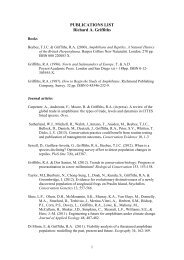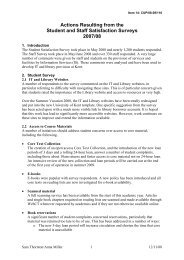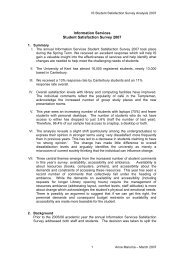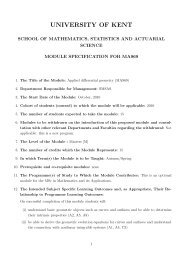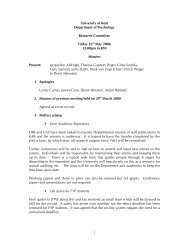You also want an ePaper? Increase the reach of your titles
YUMPU automatically turns print PDFs into web optimized ePapers that Google loves.
1<br />
1. Suppose there are four cities, located at the corners of a square with<br />
sides of length 4. A network of roads is to connect all four cities. Is it<br />
possible to construct a network of length 12? 11.5? 11(*)?<br />
2. Given a triangle ABC, find a point T such that T A + T B + T C is<br />
minimal.<br />
First suppose that ABC is a triangle with largest angle at most 120 ◦ .<br />
a1. Consider a rotation around A through the angle of 60 ◦ . Suppose<br />
that the rotation sends C to D and T to N. Prove that DN + NT +<br />
T B = T A + T C + T B.<br />
a2. Prove that AT + BT + CT BD. When does the equality hold?<br />
Now suppose that ∠A 120 ◦ .<br />
b1. Let M ∉ ∠A. Prove that MA + MB + MC > AB + AC.<br />
b2. Let M ∈ ∠A. Once again consider the rotation around A through<br />
the angle of 60 ◦ . Suppose that the rotation sends C to D and T to N.<br />
Prove that AB + AC BM + AM + CM<br />
3. Given N points A 1 , . . . , A N in the plane, the goal is to connect them<br />
by a network consisting of line segments of minimum total length. An<br />
example is shown on Figure 1. There can be other points (apart from<br />
A 1 , . . . , A N ) where two or more line segments meet. These are marked<br />
by B i on the figure. They are called <strong>Steiner</strong> points. The initial points<br />
A 1 , . . . , A N are called real points.<br />
Suppose the network of minimal total length is found.<br />
a. Prove that the angle between any two line segments incident to the<br />
common point is greater or equal than 120 ◦ .<br />
b. Prove that there are no more than 3 line segments incident to a<br />
real point.<br />
c. Prove that there are exactly 3 line segments incident to a <strong>Steiner</strong><br />
point, and the angles between them are equal to 120 ◦ .<br />
Define a <strong>Steiner</strong> tree as a network with the properties (a)-(c). We’ve<br />
just proved that a minimal network is a <strong>Steiner</strong> tree.<br />
4. A real point A is called a deadlock vertex, if there’s only one line<br />
segment that connects it to another point B, and B is also real. A<br />
pair of deadlock vertices is a pair of two real points A, B, such<br />
that each of A and B has exactly one line segment incident to it, and<br />
these two line segments are incident to a common <strong>Steiner</strong> point.
2<br />
Figure 1: An example of <strong>Steiner</strong> tree<br />
A<br />
1<br />
A2<br />
A3<br />
B1<br />
A<br />
4<br />
A5<br />
B2<br />
A<br />
6<br />
B<br />
3<br />
A7<br />
B<br />
4<br />
A<br />
8
3<br />
Figure 2: Deleting deadlock vertex A<br />
B C B C<br />
A<br />
(In Figure 1 A 2 , A 4 are deadlock vertices, A 7 and A 8 form a pair of<br />
deadlock vertices.)<br />
Prove that every <strong>Steiner</strong> tree has either a deadlock vertex or a pair of<br />
deadlock vertices.<br />
Hint: Consider a path in the <strong>Steiner</strong> tree consisting of the maximal<br />
number of line segments.<br />
5. Try to guess a minimal network for four points at the corners of a<br />
square.<br />
6. Now we would like to construct all the <strong>Steiner</strong> trees for N given points.<br />
Firstly we will verify that the problem of constructing <strong>Steiner</strong> trees for<br />
N points reduces to the analogous problem for N − 1 points.<br />
For that we will prove that from any given <strong>Steiner</strong> tree S N for N points<br />
one can construct some <strong>Steiner</strong> tree S N−1 for N − 1 points.<br />
Note that S N has either a deadlock vertex or a pair of deadlock vertices.<br />
a. In the first case just delete the deadlock vertex (see Figure 2). The<br />
remainder is a <strong>Steiner</strong> tree for N − 1 points.<br />
b. In the second case everything is a little bit more complicated (see<br />
Figure 3). Let A 1 , A 2 be a pair of deadlock vertices, A 1 B, A 2 B be<br />
the incident line segments, the <strong>Steiner</strong> point B is connected with a<br />
point K. In order to decrease N we could delete the points A 1 , A 2 ,<br />
but the result would consist of N − 2 real points and wouldn’t be a<br />
<strong>Steiner</strong> tree (why?). So we would like to put an additional real point<br />
M somewhere.<br />
Construct the equilateral triangle ADM.<br />
b1. Prove that M belongs to the circle circumscribed about triangle<br />
ADM.<br />
b2. Prove that B ∈ KM. Construct a <strong>Steiner</strong> tree for N − 1 points.<br />
7. We will construct <strong>Steiner</strong> trees by induction.
4<br />
Figure 3: Deleting a deadlock pair A<br />
K<br />
K<br />
A<br />
1<br />
B<br />
A<br />
2<br />
M<br />
M<br />
a. Construct a <strong>Steiner</strong> tree for N = 2<br />
b. Suppose we know how to construct a <strong>Steiner</strong> tree for N − 1 points.<br />
Using the previous problem, think about an algorithm that would<br />
allow us to construct all the <strong>Steiner</strong> trees for N points.<br />
Hint: The first way is to delete an arbitrary point A j temporarily, to<br />
construct a <strong>Steiner</strong> tree S for A i , i = 1, . . . , j −1, j +1, . . . , N. Connect<br />
A j with an arbitrary vertex A k from S. Check whether the result is a<br />
<strong>Steiner</strong> tree. Repeat for all A k , A j possible.<br />
Using the previous problem, think about the second way.<br />
8. Construct all the <strong>Steiner</strong> trees for a triangle.<br />
9. Construct all the <strong>Steiner</strong> trees for a square.



